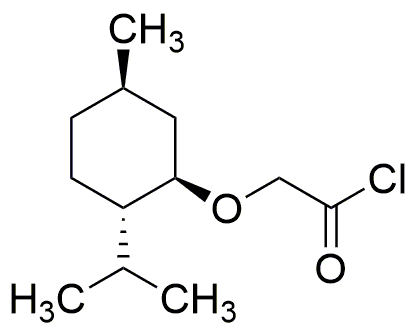(-)-Menthoxyacetyl chloride is widely utilized in research focused on
- Synthesis of Pharmaceuticals: This compound serves as a key intermediate in the synthesis of various pharmaceutical agents, particularly in the development of analgesics and anti-inflammatory drugs. Its unique structure allows for the modification of drug properties, enhancing efficacy.
- Flavor and Fragrance Industry: It is used in the formulation of flavoring agents and fragrances due to its pleasant minty aroma. This application is particularly valuable in creating appealing products in the food and cosmetics sectors.
- Organic Synthesis: Researchers leverage its reactivity in organic synthesis to create complex molecules. Its ability to participate in acylation reactions makes it a versatile building block in chemical manufacturing.
- Research in Chemical Biology: The compound is employed in chemical biology studies to modify biomolecules, aiding in the understanding of biological processes and the development of new therapeutic strategies.
- Polymer Chemistry: It finds application in the production of specialty polymers, where it acts as a modifying agent to enhance the properties of polymeric materials, making them suitable for specific industrial applications.
General Information
Properties
Safety and Regulations
Applications
(-)-Menthoxyacetyl chloride is widely utilized in research focused on
- Synthesis of Pharmaceuticals: This compound serves as a key intermediate in the synthesis of various pharmaceutical agents, particularly in the development of analgesics and anti-inflammatory drugs. Its unique structure allows for the modification of drug properties, enhancing efficacy.
- Flavor and Fragrance Industry: It is used in the formulation of flavoring agents and fragrances due to its pleasant minty aroma. This application is particularly valuable in creating appealing products in the food and cosmetics sectors.
- Organic Synthesis: Researchers leverage its reactivity in organic synthesis to create complex molecules. Its ability to participate in acylation reactions makes it a versatile building block in chemical manufacturing.
- Research in Chemical Biology: The compound is employed in chemical biology studies to modify biomolecules, aiding in the understanding of biological processes and the development of new therapeutic strategies.
- Polymer Chemistry: It finds application in the production of specialty polymers, where it acts as a modifying agent to enhance the properties of polymeric materials, making them suitable for specific industrial applications.
Documents
Safety Data Sheets (SDS)
The SDS provides comprehensive safety information on handling, storage, and disposal of the product.
Product Specification (PS)
The PS provides a comprehensive breakdown of the product’s properties, including chemical composition, physical state, purity, and storage requirements. It also details acceptable quality ranges and the product's intended applications.
Certificates of Analysis (COA)
Search for Certificates of Analysis (COA) by entering the products Lot Number. Lot and Batch Numbers can be found on a product’s label following the words ‘Lot’ or ‘Batch’.
*Catalog Number
*Lot Number
Certificates Of Origin (COO)
This COO confirms the country where the product was manufactured, and also details the materials and components used in it and whether it is derived from natural, synthetic, or other specific sources. This certificate may be required for customs, trade, and regulatory compliance.
*Catalog Number
*Lot Number
Safety Data Sheets (SDS)
The SDS provides comprehensive safety information on handling, storage, and disposal of the product.
DownloadProduct Specification (PS)
The PS provides a comprehensive breakdown of the product’s properties, including chemical composition, physical state, purity, and storage requirements. It also details acceptable quality ranges and the product's intended applications.
DownloadCertificates of Analysis (COA)
Search for Certificates of Analysis (COA) by entering the products Lot Number. Lot and Batch Numbers can be found on a product’s label following the words ‘Lot’ or ‘Batch’.
*Catalog Number
*Lot Number
Certificates Of Origin (COO)
This COO confirms the country where the product was manufactured, and also details the materials and components used in it and whether it is derived from natural, synthetic, or other specific sources. This certificate may be required for customs, trade, and regulatory compliance.


